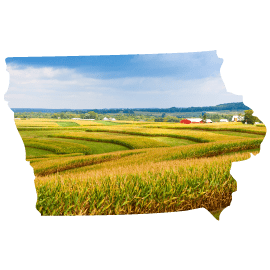Measures of Student Growth: Iowa
Teacher and Principal Evaluation Policy
Note
The data and analysis on this page is from 2019. View and download the most recent policy data and analysis on Measures of Student Growth in Iowa from the State of the States 2022: Teacher and Principal Evaluation Policies report.
Analysis of Iowa's policies
Impact of Student growth: Iowa does not require measures of student growth in its teacher evaluation system. Local districts are responsible for the development of teacher evaluations, although the state provides some guidance. Iowa requires that its districts' teacher evaluation systems take into consideration classroom observations as well as a review of teachers' individual career development plans to determine whether teachers are meeting the state's teaching standards.
Iowa convened a task force, The Council on Educator Development, to develop a statewide teacher evaluation system that includes "balanced consideration" of student growth measures, when available, for teachers of tested subjects and grades. It is unclear whether the state still utilizes the Council's recommendations published in its 2016 report.These recommendations indicate that student growth goals are tracked on teacher evaluations, but there is no indication that these goals must be connected to objective measures of student growth.
State's Role in Evaluation System: Iowa provides some guidance for districts to support their design of evaluation systems.
Recommendations for Iowa
Require objective measures of student growth to be included in teacher evaluation.
Iowa should require that objective measures of student growth be included in a teacher's evaluation rating, and that such measures play a profound role in a teacher's overall evaluation rating.
State response to our analysis
Iowa recognized the factual accuracy of this analysis.
Updated: June 2019
Select another topic
Teacher Preparation
- Program Entry
- Teacher Shortages and Surpluses
- Program Performance Measures
- Program Reporting Requirements
- Student Teaching/Clinical Practice
Elementary Teacher Preparation
Secondary Teacher Preparation
- Middle School Content Knowledge
- Middle School Licensure Requirements
- Secondary Content Knowledge
- Secondary Licensure Requirements
Special Education Teacher Preparation
Alternate Routes
Teacher Diversity
Hiring
Teacher and Principal Evaluation
Teacher Compensation
Early Childhood Preparation
Retaining Effective Teachers
How we graded
7A: Measures of Student Growth
- Student Growth: The state should require:
- That districts use an evaluation instrument that includes objective student growth measure
- Full credit: The state will earn full credit if it requires teacher evaluations to include objective measures of student growth.
Research rationale
Many factors should be considered in formally evaluating a teacher; however, nothing is more important than effectiveness in the classroom. Value-added models are an important tool for measuring student achievement and school effectiveness.[1] These models have the ability to measure individual students' learning gains, controlling for students' previous knowledge and background characteristics. While some research suggests value-added models are subject to bias and statistical limitations,[2] rich data and strong controls can eliminate error and bias.[3] In the area of teacher quality, examining student growth offers a fairer and potentially more meaningful way to evaluate a teacher's effectiveness than other methods schools use.
Unfortunately, districts have used many evaluation instruments, including some mandated by states, which are structured so that teachers can earn a satisfactory rating without any evidence that they are sufficiently advancing student learning in the classroom.[4] Teacher evaluation instruments should include factors that combine both human judgment and objective measures of student learning.[5]
[1] Hanushek, E. A., & Hoxby, C. M. (2005). Developing value-added measures for teachers and schools. Reforming Education in Arkansas, 99-104.; Clotfelter, C. & Ladd, H. F. (1996). Recognizing and rewarding success in public schools. In H. Ladd (Ed.), Holding schools accountable: Performance based reform in education (pp. 23-64). Washington, DC: Brookings Institution Press.; Ladd, H. F., & Walsh, R. P. (2002). Implementing value-added measures of school effectiveness: Getting the incentives right. Economics of Education Review, 21(1), 1-17.; Meyer, R. H. (1996). Value-added indicators of school performance. In E. A. Hanushek (Ed.), Improving America's schools: The role of incentives, (pp. 197-223). Washington, D.C.: National Academy Press.; Braun, H. I. (2005). Using student progress to evaluate teachers: A primer on value-added models. Educational Testing Service.
[2] Rothstein, J. (2009). Student sorting and bias in value-added estimation: Selection on observables and unobservables. Education, 4(4), 537-571.; McCaffrey, D. F., Lockwood, J. R., Koretz, D., Louis, T. A., & Hamilton, L. (2004). Models for value-added modeling of teacher effects. Journal of Educational and Behavioral Statistics, 29(1), 67-101.; Darling-Hammond, L., Amrein-Beardsley, A., Haertel, E., & Rothstein, J. (2012). Evaluating teacher evaluation. Phi Delta Kappan, 93(6), 8-15.; McCaffrey, D. F., Lockwood, J. R., Koretz, D. M., & Hamilton, L. S. (2003). Evaluating value-added models for teacher accountability. Monograph. Santa Monica, CA: RAND Corporation.
[3] Chetty, R., Friedman, J. N., & Rockoff, J. E. (2014). Measuring the impacts of teachers II: Teacher value-added and student outcomes in adulthood. The American Economic Review, 104(9), 2633-2679.; Ballou, D., Sanders, W., & Wright, P. (2004). Controlling for student background in value-added assessment of teachers. Journal of Educational and Behavioral Statistics, 29(1), 37-65.; Chetty, R., Friedman, J. N., & Rockoff, J. E. (2014). Measuring the impacts of teachers I: Evaluating bias in teacher value-added estimates. The American Economic Review, 104(9), 2593-2632.
[4] Weisberg, D., Sexton, S., Mulhern, J., Keeling, D., Schunck, J., Palcisco, A., & Morgan, K. (2009). The widget effect: Our national failure to acknowledge and act on differences in teacher effectiveness. New Teacher Project.; Glazerman, S., Loeb, S., Goldhaber, D., Staiger, D., Raudenbush, S., & Whitehurst, G. (2010). Evaluating teachers: The important role of value-added. Washington, D.C.: Brookings Institution.
[5] Kane, T. J., Taylor, E. S., Tyler, J. H., & Wooten, A. L. (2011). Identifying effective classroom practices using student achievement data. Journal of Human Resources, 46(3), 587-613.; Taylor, E. S., & Tyler, J. H. (2012). The effect of evaluation on teacher performance. The American Economic Review, 102(7), 3628-3651.

